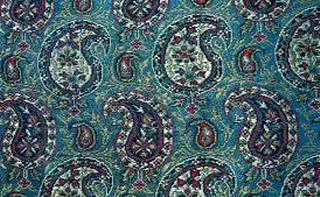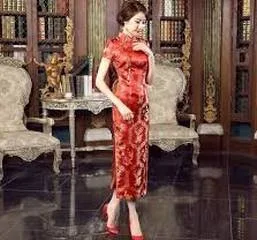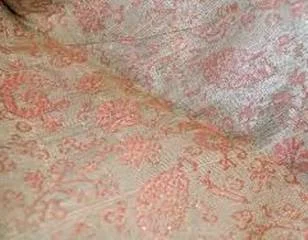Brocade fabric
Brocade fabric is a class of rich decorative shuttle woven fabrics often
made in colored silk and with or without gold and silver threads. The name, which has
the same roots as the word broccoli, comes from the Italian broccato meaning embossed
cloth, originally from the broccare verb means set with nails in the stud, from
the brocco means small nail, comes from the Latin brocas, means projecting or
pointed.
Brocade fabric history
Back
in the middle Ages, brocade fabric was one of the few luxury fabrics worn by
the aristocracy throughout China, India, Persia, Greece, Japan, Korea, and
Byzantium. Woven by Byzantine, brocades were a particularly desirable fabric.
From the 4th to the 6th-century silk production was seemingly non-existent, as
linen and wool were the main textiles. During this period, there was no public
knowledge about silk fabric production which the Chinese kept secret. Over the
years, knowledge about silk production became known among other cultures and
spread westward. As silk production became known in Western culture, trade from
the East began to decline.
Brocade the cloth was only available to the rich since the Byzantine emperor set extreme
prices for the fabric. The woven designs of brocade fabric were often
originally Persian. Wealthy rich men and aristocratic women wore silk brocades
from Italy, and velvet was trimmed from Germany. During the 14th and 15th
centuries, the courts of Burgundy became known for their unmistakable
fashionable taste and luxurious dress. Brocade fabrics are now mostly woven
into jacquard looms which are able to create many intricate tapestry-like
designs using jacquard technology.
Fabric description
Brocade
emphasizes decorative features and serves as an addition to the main fabric,
sometimes making it stiffer although it often creates a less relaxing effect on
the face. In some cases brocades, these additions represent a distinct presence
on the back of the material where the complementary weft or floating threads of
the brocade or broached parts hang or fall off in loose groups. Complementary
weft moves from Selvage to Selvage. The yarns are cut and broached also, an
isolated brocade where the complementary yarn is woven only in the patterned
area.
Properties of brocade fabric
1.
Brocade fabric is a rich class decorative shuttle woven fabric often create in
colored silk and with or without gold and silver threads.
2.
It is mainly woven on a drawloom
and supplementary weft method.
3.
It is not reversible like a damask weave often used for a tablecloth fabric.
4.
Brocade fabric is one of the few luxury fabrics.
5.
Authentic brocade is skillfully woven using breathable cotton, which means you
will feel cool and comfortable even in extremely hot weather.
6.
It is emphasized and served as an addition to the original fabric, sometimes
making it stiffer although it often creates a less relaxing effect on the face.
Types of brocade fabric
1. Amru brocade fabric
Woven
on the principle of extra weft, Amru is woven from brocade silk and zari to
create varied designs. It can be very beautiful with pseudo-rich effects in
general. It has continued to be in popular demand due to its lower price than
pure silk brocade. Another aspect of this is that it can be woven very finely
so that it gives a soft feeling, thus making it more suitable as a fabric for
personal wear than true brocade.
2. Abrawans brocade fabric
The
sarees of Abrawans, known as Banaras, are quite acclaimed in India for their
fabric and gorgeousness, and style. The transparent materials of this saree are
usually woven with the finest silk thread. It has earned them the name abrawan
which means flowing water. The most luxurious saree, known as tarbana which
means woven water or tissue saree, has a fine silk cut with a lace weft. These
give the sarees a metallic shine and luster.
3. Zari brocade fabric
‘Zari
Brocades’ are widely regarded as a wedding saree. In this brand, golden cords
are used to create deep designs and this is the main attraction. The specialty
of this brand is that the base fabric will not be clearly noticeable due to the
dense fabric design. This ingredient is also referred to as ‘kimkhab’.
Brocade mechanism
Brocade fabrics
are specially made fabrics in which weaving designs are made by inserting cords
in the middle of the wrapper. During weaving, in the general case, the weft
cord runs regularly on top and bottom of the repeatedly wrapped cord. It should
also be mentioned here that the original zari is made from real gold. Another
thing to note is that a special loom is used to make ‘brocades’. When making
‘brocades’ the cords are lifted and lowered unevenly, thus bringing a printed
image to the fabric.
Uses of brocade fabric
1. Brocade
fabrics are mostly used for upholstery and draperies.
2. It
is also used for evening and formal dresses, vestments, and costumes.
3. Banarasi
brocade fabrics are widely used for women's fashion in the form of sarees,
garments, and dupattas.
4.
The use of precious and semi-ancient stones in brocades ornaments is not common
but has been replaced by the use of sequins and beading as decorations.













0 Comments